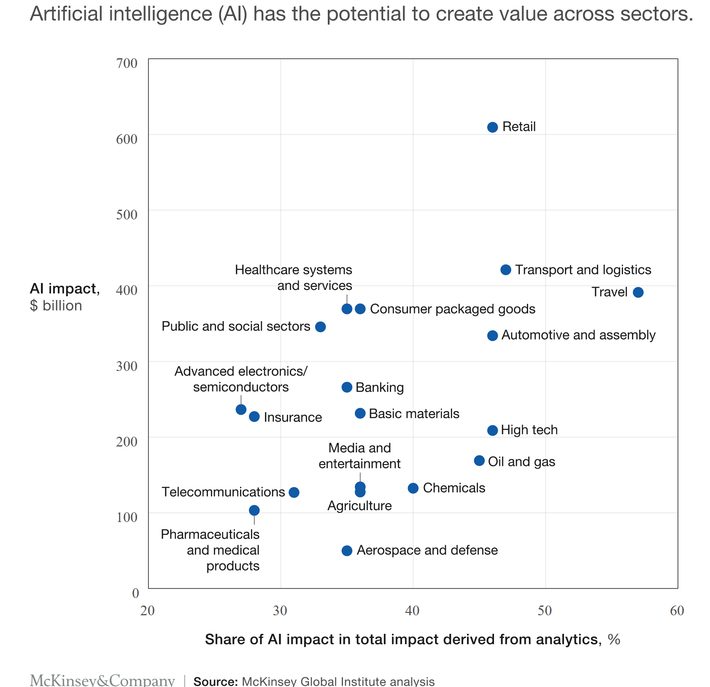Summary: If you are guiding your company’s digital journey, to what extent should you be advising them to adopt deep learning AI methods versus traditional and mature machine learning techniques.
 By now everyone is at least familiar with using AI/ML as a required cornerstone of company strategy. Frequently this is referred to as ‘digitization’ or the ‘digital journey’. There’s plenty of data showing that early adopters who have gone all-in on this approach are already pulling ahead of competitors both in share and bottom line results.
By now everyone is at least familiar with using AI/ML as a required cornerstone of company strategy. Frequently this is referred to as ‘digitization’ or the ‘digital journey’. There’s plenty of data showing that early adopters who have gone all-in on this approach are already pulling ahead of competitors both in share and bottom line results.
There’s also mounting evidence that even though most companies are now aware of this need, either their planning or their execution has been half-hearted. We are on the upswing of this movement and like many previous revolutions in technology and management, the leaders are pulling away and the rest of the pack is about to get a wake-up call.
So as a data scientist in these companies, you are increasingly likely to be called on to participate, either by leading or supporting the teams assembled for specific projects or for the formulation of the broader strategy and the prioritization of projects within that effort.
The Problem with ‘Digitization’
The problem with ‘digitization’ is that this naming convention seems to focus on the data (good) without adequate understanding the very many advanced analytic techniques from which to choose (bad).
Thinking back to previous breakthroughs in technology-driven performance improvement like reengineering or Six Sigma, we all understood that there were fairly safe and mature techniques with reasonably predictable outcomes versus bleeding edge techniques that promised extraordinary outcomes but came with extraordinary risks.
We’re in a very similar place today regarding which data science tools should be applied to which projects. Although data science projects and the whole digital journey has become a team sport with many different types of participants, it’s likely that only you, the data scientist, will have a grasp of the risks versus the rewards of different tools.
Machine Learning versus Deep Learning
Part of the problem is our own internal naming conventions. Increasingly everything we do is simply called ‘artificial intelligence’ (AI). Personally I’ve adopted the practice of calling this ‘AI/ML’ so we don’t lose track of the fact that our powerful and mature machine learning techniques are far and away the most widely adopted techniques.
And for purposes of making this absolutely clear in this article I’m using the more accurate ‘deep learning’ to describe what we’re doing with deep neural nets and reinforcement learning. This is much closer to the true differentiation between ML and AI.
Deep learning then encompasses CNNs, RNNs, LSTMs, GANs, deep feed forward NNs, reinforcement learning, and techniques like transfer learning. In application this would cover image and video processing and search, text and audio processing, game play as optimization, and several versions of time series forecasting.
Is It Time to Recommend Deep Learning Solutions for Business
So here is the core of the question. Given that deep learning solutions often require much larger quantities of data, that they are often difficult to train, that they require specialized skills to build, implement, and maintain – in other words all heightened elements of risk – is it time to start recommending these techniques as a regular part of your company’s digital journey?
The alternative would be to continue to focus on advanced machine learning techniques that are mature and well understood. So, for example, since essentially all of classification, continuous estimation, clustering, optimization, and anomaly detection can be performed well with traditional ML (with the possible exception of some pure image and text applications) should we be recommending deep learning techniques just because they can also perform in these tasks?
McKinsey’s Take
In a recent series of studies by the McKinsey Institute they have come down strongly on the side of yes. Using the same fairly strict definition of AI we’ve used here (just deep learning and reinforcement learning), they concluded that “in two-thirds of use cases, AI can improve performance beyond other analytic techniques.”
Further, they suggest the increase in value is quite substantial.
“On average, our use cases suggest that modern deep learning AI techniques have the potential to provide a boost in additional value above and beyond traditional analytics techniques ranging from 30 percent to 128 percent, depending on industry.”
And that potential increase in value over ML does indeed vary a great deal by industry:

Travel, transport and logistics, retail, automotive assembly, high tech, and oil and gas are projected to reap the greatest reward by adding AI to their digital journey.
Digging down into the report, they give some examples of where AI would add the greatest value.
Retail: Pricing and promotion and customer service management are the main value areas. “Our use cases show that using customer data to personalize promotions, for example, including tailoring individual offers every day, can lead to a one to two percent increase in incremental sales for brick-and-mortar retailers alone.”
Consumer Goods: Supply chain management, primarily by increasing the accuracy of forecasting. Improving “forecasting accuracy by 10 to 20 percent, which translates into a potential five percent reduction in inventory costs and revenue increases of two to three percent.”
Retail Banking: marketing and sales, loan underwriting and fraud detection.
A Slightly Different Take
I’ve always had the utmost respect and appreciation for the studies performed by McKinsey but in this case I’d like to back off a little.
This implies that companies should embrace AI techniques just a rapidly and completely as ML techniques. I’m not sure McKinsey has adequately assessed the difficulty, risks, or level of effort associated with such an enthusiastic embrace.
There are certainly some AI techniques and tools that are almost fully mature and frankly can be purchased off the shelf. Here I’m thinking primarily of chatbots. Their benefits and cost savings are substantial.
But the other areas mentioned above, particularly in marketing, sales, pricing, forecasting, and fraud detection can be done very satisfactorily with traditional ML. Further our ML techniques are more transparent, easier to build, and the skill sets necessary for development much more widely available.
If you are involved in recommending or evaluating potential projects you need to be much more specific about the capabilities of your own team (do you have deep learning expertise and experience), and is the potential improvement worth the additional effort.
Yet Another Angle
When we think of deep learning problems we automatically go to image and text inputs. Once these are labeled they can then be used by our deep neural nets to classify or forecast.
Don’t forget however that DNNs are not completely necessary to extract value from image and text data. It’s completely possible to classify image and text more simply as data inputs to traditional ML models.
For example, a model I’m familiar with used to predict which renter prospects were most likely to become actual renters analyzed their email communication with the rental agent and found patterns associated with completing the transaction. These text indicators (now reduced to a numerical score) were used as an additional input to existing ML models and improved the accuracy significantly.
The same could be done with image data, using new signals as input to existing classification models to improve accuracy. The point of course is that it’s not always necessary to go fully DNN to extract predictive value from image and text data.
I remain excited and hopeful about pure AI techniques to achieve new levels of business value. However, I wouldn’t want to underestimate the risks and costs associated with these techniques.
If you lead your team down this path and the project is unsuccessful, what is the cost in terms of future buy-in? With very limited exception, traditional ML methods can accomplish the great majority of what you intend on your digital journey, achieving most of the value with little of the risk.
Other articles by Bill Vorhies
About the author: Bill is Contributing Editor for Data Science Central. Bill is also President & Chief Data Scientist at Data-Magnum and has practiced as a data scientist since 2001. His articles have been read more than 1.5 million times.
He can be reached at:
